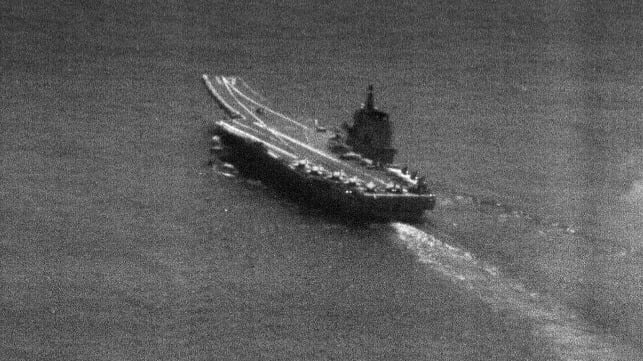Chinese Carrier Shows Up Off Luzon Amidst Growing S. China Sea Tensions

Last week, as tensions between China and the Philippines spiked in the South China Sea, the Chinese aircraft carrier Shandong left port and operated off Luzon, based on satellite imaging from European and Chinese sources. It was China's first deployment of an aircraft carrier to waters near the Philippines, according to Chinese state media outlet Global Times.
Last week, imaging from the Sentinel-2 satellite showed the carrier under way about 200 nautical miles to the northwest of the Philippines' main island. Chinese media forecast that Shandong would head south towards Palawan, then transit out to the Western Pacific. A task force of Chinese destroyers and amphibious assault vessels was already waiting in the area.
Chinese state media outlets and commentators have interpreted the carrier deployment as a message - a cue to Manila to stop defending the Philippines' exclusive economic zone (EEZ) and allow China to assert its sweeping territorial claims, which were invalidated by an international tribunal in 2016.
"To the Philippines that has been conducting infringing provocations, these forces will naturally become a deterrence [sic], as the Chinese military will resolutely defend China's territorial sovereignty and maritime rights," Chinese military commentator Zhang Junshe told Global Times.
Over the weekend, Shandong returned to waters closer to mainland China. The latest open-source sighting via Sentinel-2 put the carrier about 100 nautical miles off Hainan Island, on the far side of the South China Sea from Luzon.
Shandong is a ski-jump carrier commissioned in 2019, and it is closely modeled on the Soviet-built Liaoning, China's first carrier. It operates with an airwing of fourth-generation J-15 fighters, which are derived from the Russian Su-33, the carrier-based version of the Soviet Su-27.
Dangerous standoff
The political effects of the China Coast Guard's attack on Philippine servicemembers last month continue to reverberate in Manila and Washington, where officials are attempting to walk a narrow path between showing resolve or "instigating war" with China.
On June 17, China Coast Guard servicemembers in eight motorboats set upon two Philippine Navy RHIBs as they lay alongside the hull of the BRP Sierra Madre, the grounded ship that serves as an outpost at Second Thomas Shoal. The CCG personnel were armed with axes, knives, and spears, and they repeatedly rammed the Philippine boats at high speed. Eight of the Philippine servicemembers were injured, including one who lost his thumb when his boat was rammed.
"That this incident did not erupt into a full-scale armed conflict is down to two elements: Restraint and luck," said Collin Koh, maritime security scholar at the S Rajaratnam School of International Studies, in a new op-ed. "There was just sheer luck that the confrontation resulted in just one severe casualty, even if it was the most serious to date. But can one continue to count on luck even if one or both parties exercise some level of restraint?"

that matters most
Get the latest maritime news delivered to your inbox daily.
The administration of President Ferdinand Marcos Jr. has tread carefully in formulating a response. Marcos has called the assault on Philippine troops "illegal" and "deliberate," but his deputies have also claimed that the encounter was "not an attack" because the China Coast Guard only wielded knives and axes. According to some observers, Manila's response reflects the uncertainties of its supporters in Washington.
"The dithering and seemingly confused statements from Philippine officials . . . are a reflection of fears of unwanted escalation and, crucially, doubts over the extent of America’s commitment to come to the country’s aid," commented Richard Heydarian, a Manila-based defense scholar. "America’s credibility as both an ally and regional leader is under growing question, thanks to China’s efforts to alter the status quo based on its expansive claims in one of the world’s most important seascapes.."
